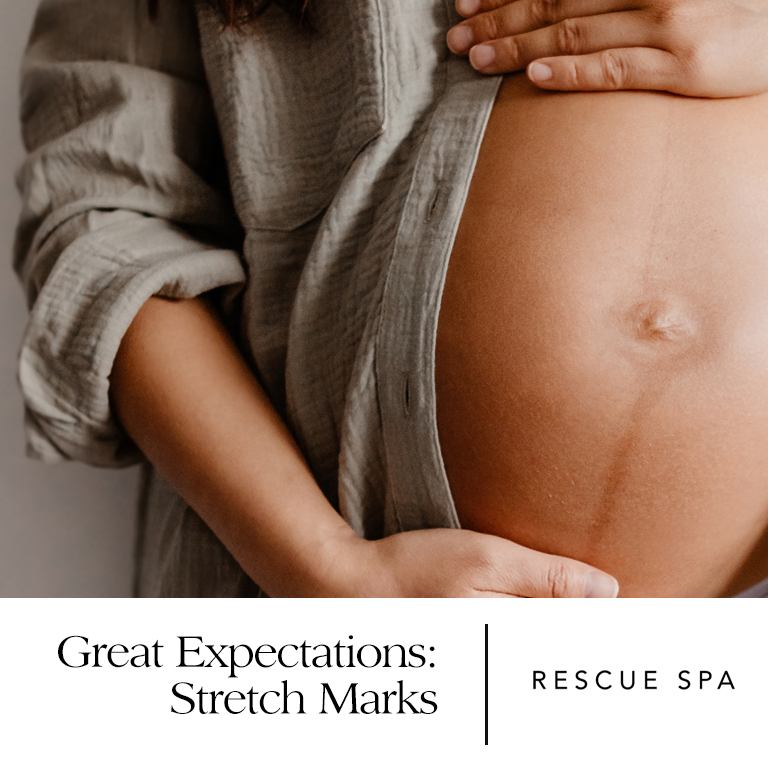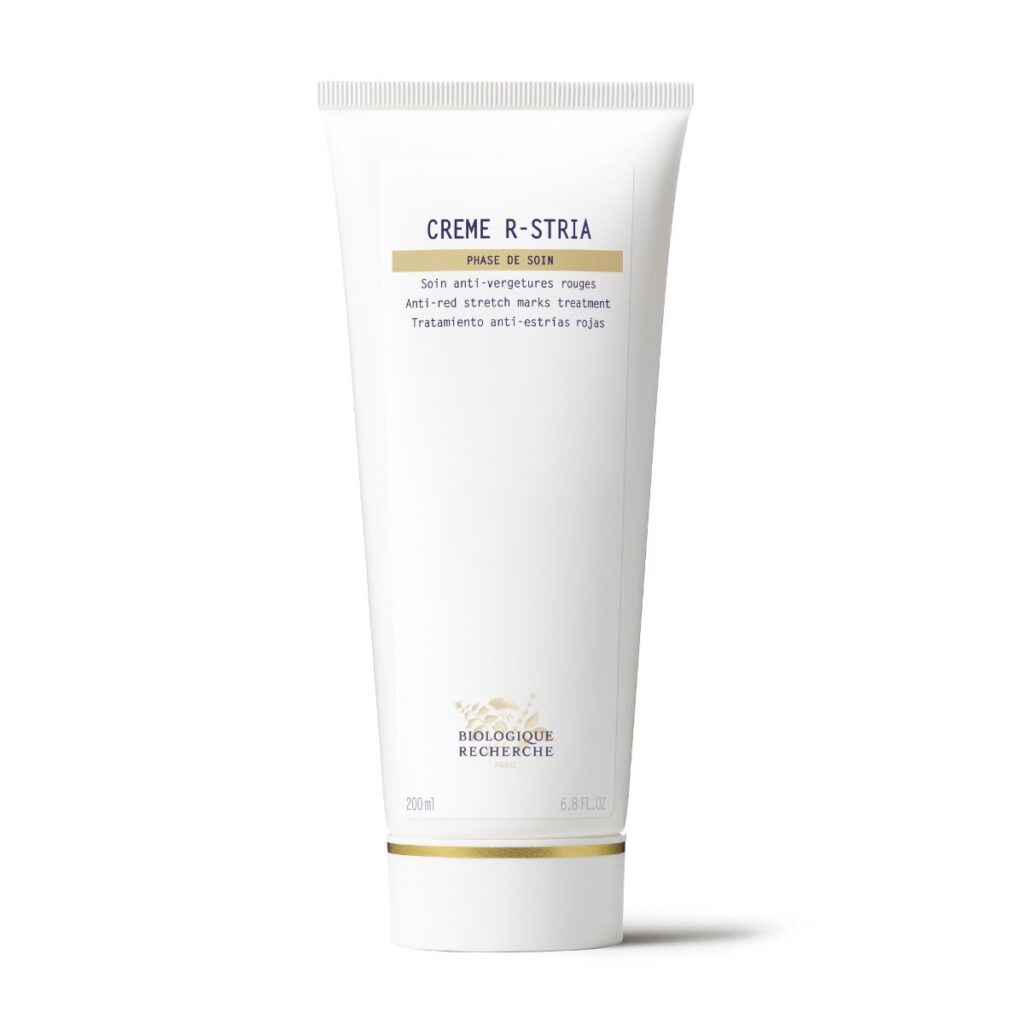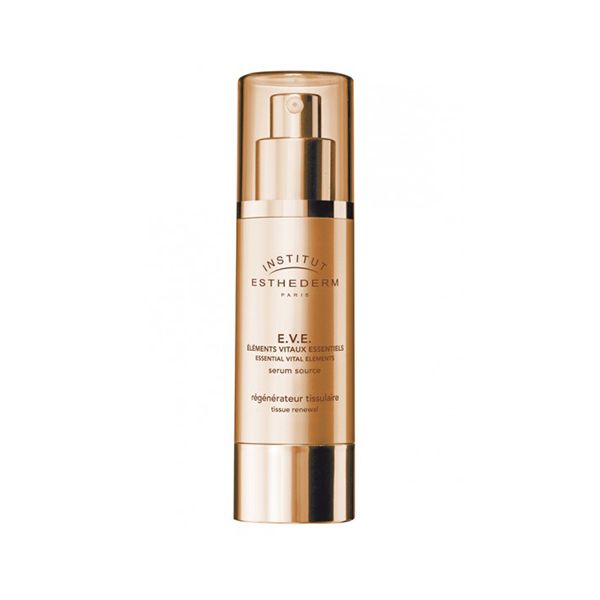By Kate Elliot, Esthetician
When preparing for pregnancy, stretch marks can be a worrisome topic for expecting mothers, but they don’t have to be. Most women view pregnancy stretch marks somewhere between a badge of honor for achieving one of life’s greatest milestones or something they wish to avoid altogether. If you’re leaning towards finding ways to avoid pregnancy stretch marks, here are some tips on how to be one step ahead of them.

“8 out of 10 women experience this change and it often appears on the stomach, thighs, and breasts. “
When the body begins to make changes for the baby, you may see and feel a lot of different things happening all at once. This natural process is beautiful, but can also be overwhelming. Women can see changes to their hair, nails, mood, appetite, and a lot of times, the skin. The hormones produced during pregnancy can often be a rollercoaster ride for the skin. The infamous “pregnancy glow” is sometimes masked by symptoms of melasma, or even breakouts and increased oiliness. But an even more common concern for women is stretch marks. 8 out of 10 women experience this change and it often appears on the stomach, thighs, and breasts.
What are stretch marks?
Stretch marks are experienced by anyone who is seeing rapid changes in their body composition. They can happen to teenagers during puberty, a bodybuilder who gains a lot of muscle mass, and of course, to expecting mothers. Most moms-to-be see this change during their second or third trimester. Not every woman develops them, and it seems that family history and hormones play a role. They are a type of scar that develops when the skin stretches too quickly. This change causes the collagen and elastin to rupture, and as the skin heals, these colored bands are formed. They can be red, white, purple, pink, or brown depending on your skin color.
Stretch marks are broken down into three main types based on their appearance; Striae Rubrae, Striae Albae, and Striae Gravidarum.

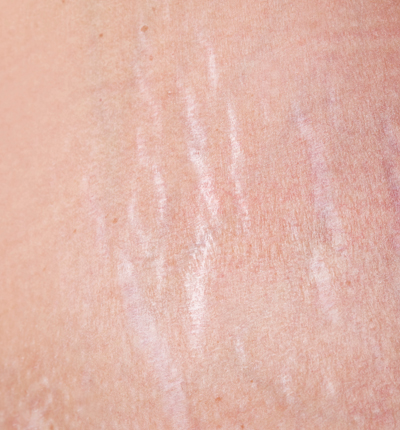
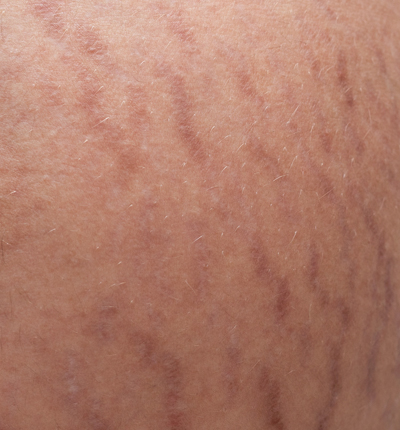
– Striae Rubrae is the earlier indication of stretched skin and is often characterized by a red or pink color due to inflammation from the breakdown of collagen and elastin. During this stage, the marks can also become itchy due to the gradual atrophy of the skin.
– Striae Albae is the more mature version of stretch marks. These marks tend to look more like scars and be darker in color. While they can fade, the lines can become more prominent with age and be harder to treat.
– Striae Gravidarum is the third type that is usually present specifically during pregnancy. They are most prominent in the abdomen, thigh, breast, and buttocks area. They start as striae rubrae and develop into parallel and side-by-side lines attributed to the body’s hormonal changes rather than perpendicular lines associated with the other types. The good news is, these specific marks do tend to fade more, especially after birth. But, the question remains; can we stop them before they begin?
Prevention
Due to the nature of stretch marks, prevention is essential. The most helpful thing you can do is maintain a healthy weight. While getting proper nutrients and nourishment for you and the baby is a top priority, being mindful of the type of foods and how much physical activity you get can make a big difference in how rapidly you gain weight. Of course, gaining weight is expected and needed, being the healthiest version of yourself can help with how fast the skin has to adjust to your new body. Eating a healthy diet can also benefit your skin’s overall health. This goes hand in hand with drinking enough water. Hydrated skin heals and adjusts faster than dehydrated skin, so ensuring you’re getting your recommended water intake can be beneficial for your skin and your baby.

Topical remedies can also play a big part in how the skin adjusts to these expected changes. Just like drinking water to ensure you’re hydrated from the inside, it’s just as important to hydrate on the outside. Keeping the skin moist and soft will make the skin more pliable when expanding to accommodate your growing baby. Creams containing vitamin E and shea butter are popular ingredients among expecting mothers, as they contain healing and hydrating qualities that can help with the prevention of stretch marks. But a true game-changing product specifically for pregnancy stretch marks is Biologique Recherche’s Creme R-Stria. It is perfect for calming the initial inflammation and helps refine the skin’s texture to prevent deeper stretch marks from forming.
Another great tool you have is right at your fingertips. When applying your hydrating lotion, take the time to massage it in until it’s fully absorbed. Massage can be immensely helpful when dealing with stretch marks and scars. If you do see some stretch marks appear, massaging the area will help increase blood circulation. This will accelerate the natural healing process to promote new tissue growth by helping the scar receive more nutrients. Treating these marks as soon as you can is best for their overall healing.
Once the baby is born, if you are left with some residual stretch marks, you can pull out all the stops if you want to. It’s best to wait until after pregnancy to use products containing retinol or AHA’s as these can affect the health of the baby. These ingredients will stimulate cellular turnover to gradually smooth and lighten the surface of the skin. Professional treatments like microdermabrasion and certain lasers can also be used to treat older, or darker stretch marks.
No matter how you choose to see them, remember how strong and resilient you are, stretch marks or not.
More product recommendations:
